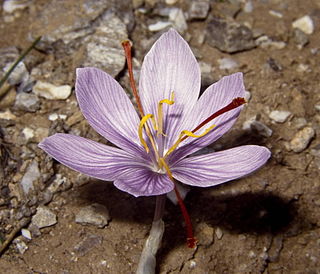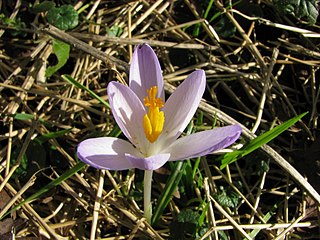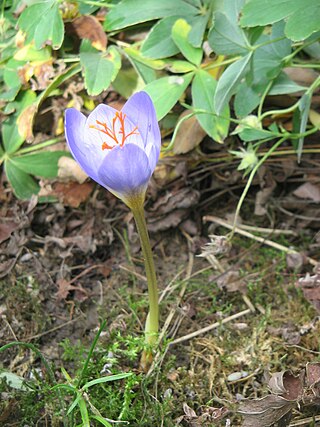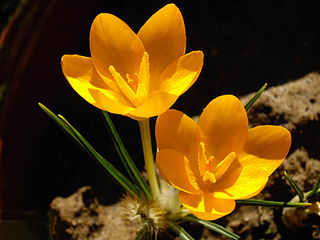
Crocus is a genus of seasonal flowering plants in the family Iridaceae comprising about 100 species of perennials growing from corms. They are low growing plants, whose flower stems remain underground, that bear relatively large white, yellow, orange or purple flowers and then become dormant after flowering. Many are cultivated for their flowers, appearing in autumn, winter, or spring. The flowers close at night and in overcast weather conditions. The crocus has been known throughout recorded history, mainly as the source of saffron. Saffron is obtained from the dried stigma of Crocus sativus, an autumn-blooming species. It is valued as a spice and dyestuff, and is one of the most expensive spices in the world. Iran is the center of saffron production. Crocuses are native to woodland, scrub, and meadows from sea level to alpine tundra from the Mediterranean, through North Africa, central and southern Europe, the islands of the Aegean, the Middle East and across Central Asia to Xinjiang in western China. Crocuses may be propagated from seed or from daughter cormels formed on the corm, that eventually produce mature plants. They arrived in Europe from Turkey in the 16th century and became valued as an ornamental flowering plant.

Crocus sativus, commonly known as saffron crocus or autumn crocus, is a species of flowering plant in the iris family Iridaceae. A cormous autumn-flowering cultivated perennial, unknown in the wild, it is best known for the culinary use of its floral stigmas as the spice saffron. Human cultivation of saffron crocus and the trade and use of saffron have endured for more than 3,500 years and span different cultures, continents, and civilizations.

Crocus cartwrightianus is a species of flowering plant in the family Iridaceae. It is native to mainland Greece, Euboea, Crete, Skyros and some islands of the Cyclades. It is a cormous perennial growing to 5 cm (2 in). The flowers, in shades of lilac or white with purple veins and prominent red stigmas, appear with the leaves in autumn and winter.

Crocus chrysanthus, the snow crocus or golden crocus, is a species of flowering plant in the family Iridaceae. It is Native to the Balkans and Turkey, it bears vivid orange-yellow bowl-shaped flowers. It has smaller corms and a smaller flower than the giant Dutch crocus, although it produces more flowers per corm than the latter. Its common name, "snow crocus", derives from its exceptionally early flowering period, blooming about two weeks before the giant crocus, and often emerging through the snow in late winter or early spring. The leaves are narrow with a silver central stripe. Height: 3–4 inches (7.6–10.2 cm).

Crocus sieberi, Sieber's crocus, also referred to as the Cretan crocus or snow crocus, is a plant of the genus Crocus in the family Iridaceae. A small, early blooming crocus, it easily naturalises, and is marked by a brilliant orange which is mostly confined to the stamens and style, fading through the bottom third of the tepal. It grows wild generally in the Balkans: Greece, especially in the island of Crete, Bulgaria, Albania and North Macedonia. There are four subtypes: sieberi (Crete), atticus, nivalis and sublimis. Its cultivars are used as ornamental plants. Height: 3–4 inches (7.6–10.2 cm).

Crocus tommasinianus, the woodland crocus, early crocus, or Tommasini's crocus, is a species of flowering plant in the family Iridaceae. It is named after the botanist Muzio G. Spirito de Tommasini (1794-1879). It is native to Bulgaria, Hungary, Albania, and the former Yugoslavia. It is often referred to as the early or snow crocus, but these terms are shared with several other species, although C. tommasinianus is amongst the first to bloom. Multiple plants are often called tommies in the horticultural trade.

Crocus biflorus, the silvery crocus or scotch crocus, is a species of flowering plant in the family Iridaceae. It is native to south-eastern Europe and south-western Asia, including Italy, the Balkans, Ukraine, Turkey, Caucasus, Iraq, and Iran. It is a cormous perennial growing to 6 cm (2.4 in) tall and wide. It is a highly variable species, with flowers in shades of pale mauve or white, often with darker stripes on the outer tepals. The flowers appear early in spring.

Crocus speciosus, with common name Bieberstein's crocus, is a species of flowering plant in the genus Crocus of the family Iridaceae. The plant is native to northern and central Turkey, the Caucasus, northern Iran, Crimea and Bulgaria.

Crocus pulchellus, the hairy crocus is a species of flowering plant in the family Iridaceae. It is found the Northern Balkan Peninsula to Northwestern Turkey.

Crocus ancyrensis, sometimes known as the Ankara crocus, is a species of flowering plant in the family Iridaceae. It is endemic to North and Central Turkey. It was named ancyrensis as it was first discovered in Ankara.

Crocus cancellatus is a species of flowering plant in the family (biology Iridaceae. It is found from the Balkan Peninsula to Iran.

Crocus ochroleucus is species of flowering plant in the Iridaceae family. It is a cream-colored crocus native to Lebanon, Palestine and Syria.

Crocus olivieri is a species of flowering plant in the family Iridaceae. It is from the Balkans, Albania, Yugoslavia and Bulgaria to Greece and Turkey.

Crocus vallicola is a species of flowering plant in the family Iridaceae. It is a cormous perennial native to north eastern Turkey to the western Caucasus.

Crocus hadriaticus is a species of flowering plant in the family Iridaceae.

Crocus gargaricus is a species of flowering plant in the family Iridaceae. It is a cormous perennial native to Turkey.
Crocus cyprius is a species of flowering plant in the genus Crocus of the family Iridaceae. It is a cormous perennial native to Cyprus where it is found in the Troödos Mountains.
Crocus aerius is a species of flowering plant in the family Iridaceae. It is a cormous perennial native to Turkey.
Crocus hartmannianus is a species of flowering plant in the genus Crocus of the family Iridaceae. It is a cormous perennial native to Cyprus.
Crocus alexandri is a species of flowering plant in the genus Crocus of the family Iridaceae. It is a cormous perennial native from Serbia to southwest Bulgaria and Greece.




















